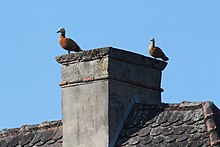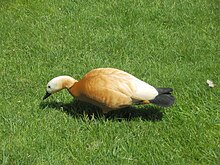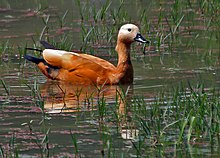Rust goose
| Rust goose | ||||||||||||
|---|---|---|---|---|---|---|---|---|---|---|---|---|
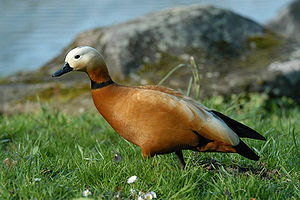
Male rust goose ( Tadorna ferruginea ) |
||||||||||||
| Systematics | ||||||||||||
|
||||||||||||
| Scientific name | ||||||||||||
| Tadorna ferruginea | ||||||||||||
| ( Pallas , 1764) |
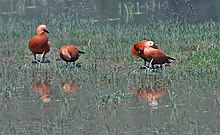
The rust goose ( Tadorna ferruginea ) is one of the seven species of the genus Tadorna , also known as Kasarkas in the German-speaking world , which belong to the subfamily Tadorninae , which is often referred to as half geese . As is characteristic of this genus, the rusty goose shows features of ducks that are rooting in the shallow water zone as well as features of grazing geese on adjacent grazing areas.
Rust geese are native to the inner Asian steppes and semi-deserts. There are wild populations in Europe, but they are all counted as captive refugees.
Surname
The German name "Rostgans" is derived from the rust-brown color of the body. The Latin name has developed in a similar way. Ferrugo is the Latin word for iron rust. The generic name Casarca, on the other hand, is a loan word from Russian. In Russian, however, the term "Kasarka" is used for the geese of the genus Branta .
Appearance
Appearance of fully grown rust geese
Both sexes are intensely colored auburn or rusty yellow and have a light yellowish or white head. The forewings are white or whitish, the wings and tail are black, the wings are emerald green. This is usually not noticeable when walking on the ground. In swimming rust geese, the white front wings are sometimes visible on the sides of the body as a white longitudinal stripe. In the flying rust geese, however, the contrast between the white front wings, the black wings and the black tail is very noticeable. Your flight is very skillful. They are also very agile fliers on steep and alpine terrain. You can often see them sitting in wait .
Both sexes are very similar. The male can be distinguished from the female by its narrow black neck ring. However, this feature is only noticeable during the breeding season, when the male is wearing the magnificent dress. In the resting dress, the black neck ring is sometimes completely missing or only hinted at in the ganter. Another distinguishing feature is that the head of the females is slightly lighter than that of the males and can appear almost white.
Males are slightly heavier than females. They have an average weight of just under 1.4 kilograms, while the females weigh an average of 1.2 kilograms.
Appearance of downy chicks and young birds
The downy chicks of the rust goose have a similarly contrasting black-brown-white plumage as those of the shelduck . Black-brown dunes are found on the back, the headstock and the neck. In contrast to the shelduck chicks, they lack the dark spot behind and under the eye. The beak of newly hatched downy chicks is blue-gray with a light brown nail. The legs are olive gray, the feet and webbed feet are gray-pink. The iris is brown. By the time young rust geese fledge, their beak is consistently dark. The legs and feet are dark olive gray and the webbed feet have turned a dark gray.
voice
The vocal repertoire of the roast goose is very variable overall. The characteristic call for rust geese are long-range, nasal-sounding trumpeting calls. They are reminiscent of those of the Canada goose , but are higher in pitch. These ang or eng calls can be heard very often. Occasionally males and females call alternately in a duet. Occasionally a soft, stretched arörr can be heard from threatening or imposing males . If a predator or a human approaches the nest cavity during the nesting period, the animals threaten with stretched necks and bowed heads. They let you hear a constantly repeated gaa .
distribution and habitat
The rusty goose is widespread mainly in the interior of Asia , where it mainly inhabits shallow, salty lakes and lagoons in steppe and desert zones . Many of the lakes it inhabits are found on high plateaus. In Tibet it breeds at heights of 5000 meters. The European breeding area extends from the Caspian Sea west to the Black Sea and also includes the south of Ukraine. There are isolated breeding occurrences in Turkey and Greece. In Romania it only breeds in the Danube Delta. It is also native to northwestern Africa. During the winter months she prefers to stay at large freshwater lakes. The large populations that are native to central Siberia in the summer months then move to the plains of north and central India, Bangladesh and south and east China as well as Taiwan and Korea. The Indian subcontinent is one of their most important wintering areas.
Unlike the shelduck , which belongs to the same genus , it is very rarely found in coastal waters. Rust geese, however, prefer open landscapes and are mainly to be found where there is a lack of larger vegetation. The absence of vegetation seems to play a bigger role in the choice of breeding grounds than the type of water. During the winter half-year, they are mostly on rivers.
Way of life
Rust geese are cave-breeders, who sometimes dig caves themselves, in which the females hatch eight to eleven, sometimes up to 16 eggs. During the breeding season, rust geese are strictly territorial and do not tolerate other ducks (Anatidae) in their territory. Rust geese feed primarily vegetarian on green parts and seeds of cultivated, steppe, littoral and aquatic plants. To search for food, they sometimes look for fields and meadows very far away from the nearest body of water. Grass is plucked in a similar way to geese. In the shallow water, rust geese eat food by chattering and shaking. In addition to vegetable food, small crustaceans, worms and insects, even fish and amphibians are consumed in small quantities.
Reproduction
Rust geese are monogamous geese. The pairing takes place in the second year of life. They intensely defend breeding territories. Similar to the shelduck , which belongs to the same genus, the rust goose prefers to nest in rock caves or cave-like structures and depressions. But she also uses abandoned bird of prey nests for her clutch. The nest is a shallow hollow that is covered with very little plant material. But it is padded with a large number of nest dunes.
The clutch consists of eight to ten eggs. These are round-oval, white in color and have a matt sheen. The time of oviposition depends on the area of distribution. In central Siberia, rust geese do not lay before mid-April. In more southerly distribution areas rust geese start breeding in mid-March. The clutch is incubated by the female alone. However, the male stays near the nest and keeps watch. The young are fleeing nests who leave the cave a few hours after hatching. Families initially remain to themselves. As soon as the young have grown up, however, the breeding birds in a breeding area and their offspring form a larger association. Fledglings are fledged at about 55 days of life and shortly thereafter are independent of the parent birds.
Rust geese as neozoa in Europe
Hartmut Kolbe points out that evidence of rust geese in Europe goes back to 1601. They show that rust geese occasionally cross the Alps. Today, however, European rust geese are classified as neozoa , as it is assumed that they are either directly captive refugees or their descendants. A rusty goose caught in Poland in 1978 and ringed in Kyrgyzstan proves that inflows from Asia continue to this day. The occurrence of the rust goose in Europe is problematic because the exotic is displacing native birds. During the breeding season it is extremely aggressive. It drives almost all ducks out of its breeding ground and also occupies incubators for barn owls and kestrels .
The largest rust gan population outside the natural range lives in Switzerland . The first roast goose to breed in the wild was discovered in Zurich in 1963 . It has been increasing exponentially for the last ten years, especially at small lakes in Aargau and Zurich . The situation at the Klingnau reservoir is dramatic : in 2004 over 400 rust geese were counted there. The rust goose is actively fought in the cantons of Aargau and Zurich: In addition to being shot, clutches are pierced to prevent breeding.
For a long time, in Germany there were only individual broods in addition to oversummer without a permanent breeding population. Breeding has occurred every year in Baden-Württemberg and North Rhine-Westphalia since the 1980s . In the Wesel district, groups of up to 140 individuals have been observed since the mid-1990s. In the Netherlands between 1961 and 1994 only 17 out of 65 breeding attempts were successful. A permanent settlement took place from the 1980s, and for the period from 1998 to 2000 the breeding population is estimated at five to twenty pairs.
Duration
The IUCN estimates the total number of rust goose at 170,000 to 220,000 animals. The species is considered "not endangered". However, this does not apply to all parts of their occurrence area. The rusty goose has largely disappeared in Romania, Greece and Turkey, where it was once widespread, and is now only found scattered with a few breeding pairs.
Cultural history
In the classical Sanskrit poetry there is a bird called Chakravaka ( चक्रवाक cakravāka ), which is identified in the Indological literature with the rusty goose (the outdated scientific name Anas casarca is often used instead of Tadorna ferruginea ). The Chakravaka bird serves as a symbol of love and loyalty in poetry. The Chakravaka male and female appear as an inseparable couple, connected in deep love. Frequently, however, reference is made to a legend according to which males and females are separated from one another at night because of a curse and spend the whole night crying out for the other. The same function as in the Chakravaka bird in Sanskrit poetry is performed by a bird called Andril ( அன்றில் aṉṟil ) in classical Tamil poetry . However, this has also been identified with the Sarus crane ( Grus antigone ) or with the warty ibis ( Pseudibis papillosa ).
literature
- Hans-Günther Bauer, Einhard Bezzel and Wolfgang Fiedler (eds.): The compendium of birds in Central Europe: Everything about biology, endangerment and protection. Volume 1: Nonpasseriformes - non-sparrow birds. Aula-Verlag Wiebelsheim, Wiesbaden 2005, ISBN 3-89104-647-2 .
- T. Bartlett: Ducks And Geese - A Guide To Management. The Crowood Press, 2002. ISBN 1-852236507 .
- John Gooders, Trevor Boyer: Ducks of Britain and the Northern Hemisphere. Dragon's World Ltd, Surrey 1986. ISBN 1-85028-022-3 .
- Hartmut Kolbe: The world's ducks. Ulmer Verlag, 1999. ISBN 3-8001-7442-1 .
- Erich Rutschke: Europe's wild ducks - biology, ecology, behavior. Aula Verlag, Wiesbaden, 1988. ISBN 3-89104-449-6 .
Web links
- Tadorna ferruginea in the endangered Red List species the IUCN 2008. Posted by: BirdLife International, 2008. Accessed January 31 of 2009.
- Videos, photos and sound recordings of Tadorna ferruginea in the Internet Bird Collection
- Page no longer available , search in web archives: Information from the Swiss Federal Office for the Environment about rust geese
- Feathers of the rust goose
Individual evidence
- ↑ Viktor Wember: The names of the birds in Europe - meaning of the German and scientific names. Aula-Verlag, Wiebelsheim, 2007. ISBN 978-3-89104-709-5 . P. 82.
- ↑ a b c Erich Rutschke: The wild ducks of Europe - biology, ecology, behavior. Aula Verlag, Wiesbaden, 1988. ISBN 3-89104-449-6 . P. 329.
- ↑ Hartmut Kolbe: The duck birds of the world. Ulmer Verlag, 1999. ISBN 3-8001-7442-1 . P. 135.
- ^ A b Collin Harrison, Peter Castell: Field Guide Bird Nests, Eggs and Nestlings. HarperCollins Publisher, 2002 revised edition. ISBN 0007130392 . P. 69.
- ^ Hans-Heiner Bergmann, Hans-Wolfgang Helb, Sabine Baumann: The voices of the birds of Europe - 474 bird portraits with 914 calls and chants on 2,200 sonograms. Aula-Verlag, Wiesbaden, 2008. ISBN 978-3-89104-710-1 . P. 51.
- ↑ a b Hartmut Kolbe: The duck birds of the world. Ulmer Verlag, 1999. ISBN 3-8001-7442-1 . P. 136.
- ↑ a b c John Gooders, Trevor Boyer: Ducks of Britain and the Northern Hemisphere. Dragon's World Ltd, Surrey 1986. ISBN 1-85028-022-3 . P. 18
- ↑ Bauer et al., P. 77
- ↑ Bauer et al., P. 78
- ↑ Bauer et al., P. 78
- ↑ Erich Rutschke: The wild ducks of Europe - biology, ecology, behavior. Aula Verlag, Wiesbaden, 1988. ISBN 3-89104-449-6 . P. 330.
- ↑ Cinzia Pieruccini: "The Cakravāka Birds: History of a Poetic Motif", in: Giuliano Boccali, Cinzia Pieruccini and Jaroslav Vacek (ed.): Pandanus '01. Research in Indian Classical Literature, Prague: Charles University in Prague, 2001, pp. 85-105.
- ↑ M. Krishnan: "The Anril", originally published 1986, reprinted without reference in: Ramachandra Guha (ed.): Nature's Spokesman. M. Krishnan & Indian Wildlife, Delhi: Oxford University Press, 2000, pp. 93-95.

